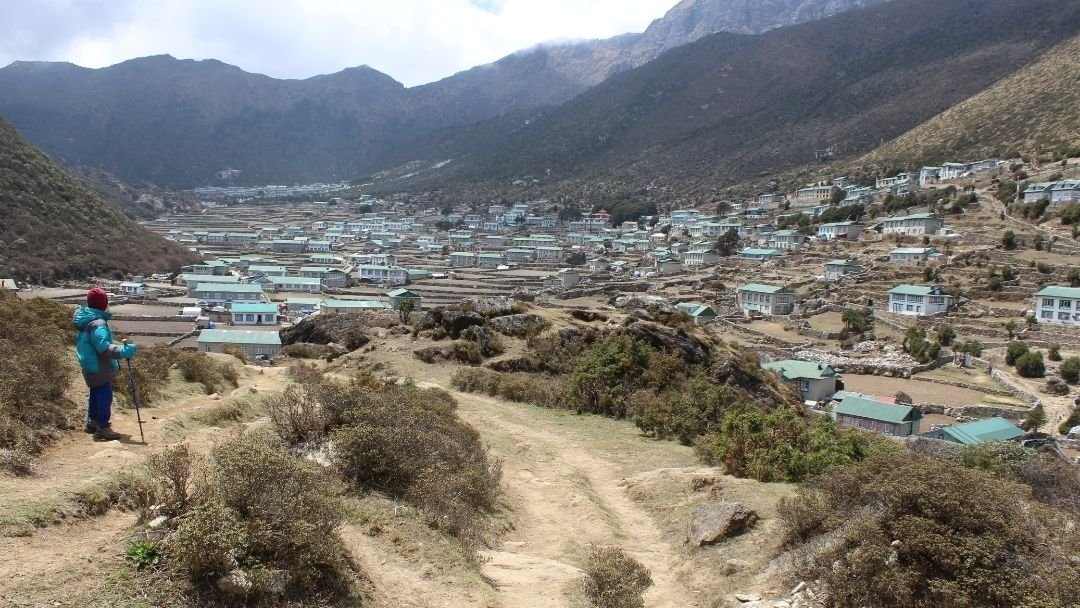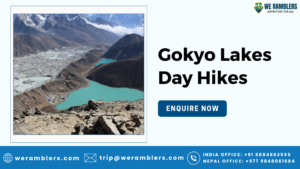Nestled in the heart of the Khumbu region of Nepal, Khumjung Village stands as one of the most culturally rich and scenic stops on the Everest trekking route. Located at a stunning Khumjung Village altitude of approximately 3,790 meters (12,430 feet), this serene settlement offers breathtaking Himalayan views and an authentic immersion into Sherpa life. It is part of the Sagarmatha National Park and sits beneath the sacred Mount Khumbila.
As a hub for acclimatization and cultural exploration, Khumjung Village plays a vital role in connecting trekkers with the spiritual and historical heritage of the Himalayas. Visitors can explore the unique architecture, spiritual landmarks, and panoramic mountain landscapes that surround this traditional village.
Sherpa Culture and Community Life in Khumjung Village
Life in Khumjung Village revolves around strong community values, religious practices, and agricultural work. The Sherpa people, known for their resilience and mountaineering prowess, maintain a lifestyle steeped in tradition and simplicity. Families grow potatoes, barley, and buckwheat while raising yaks, which provide milk, cheese, and transport. The homes are made of stone with tin roofs, built to endure the high-altitude climate.
The language spoken in the village is primarily Sherpa (a Tibetic dialect), but many residents understand Nepali and basic English due to trekking tourism. Festivals, prayer ceremonies, and daily rituals form a crucial part of life. Sherpas are known for their warmth and hospitality; offering tea or inviting guests into their homes is common.
Learning about Khumjung Village history reveals how the community evolved after the introduction of schools and health centers in the 1960s. Much of the modern development was initiated by Sir Edmund Hillary’s Himalayan Trust, forever tying this village to Everest history.
Major Landmarks in Khumjung Village
Khumjung Village houses several culturally and historically important landmarks, which make it a must-visit for those seeking deeper connections with the Himalayan region.
1. Khumjung Monastery and the Yeti Scalp
The iconic Khumjung Monastery Yeti scalp is one of the most talked-about attractions in the Everest region. Safely kept in a glass box, the alleged scalp draws curiosity and awe. Monks claim it belongs to the mythical Himalayan creature known as the Yeti. Besides the scalp, the monastery itself is a peaceful retreat for prayer and reflection, decorated with traditional murals and spinning prayer wheels.
2. Hillary School
Founded in 1961 by Sir Edmund Hillary, the school was the first of its kind in the Khumbu. Today, it provides education to over 300 students from surrounding villages. Visitors can often arrange a short tour with permission, and many are touched by the students’ eagerness to learn.
3. Edmund Hillary Hospital
Located in neighboring Khunde, this hospital has served the region for decades. It offers essential medical services to locals and trekkers, showcasing how sustainable development has benefited the Sherpa people. A short 30-minute walk from Khumjung brings you here.
Each of these landmarks reflects the unique blend of tradition and progress that defines Khumjung Village history.
Scenic Beauty and Natural Surroundings in and Around Khumjung Village
The natural surroundings of Khumjung Village offer a dreamlike experience for mountain lovers. The village lies in a wide valley, surrounded by snow-capped peaks and forests of rhododendron and pine.
- To the southeast stands Ama Dablam, considered one of the most beautiful mountains in the world.
- On clear days, you can spot Mount Everest and Lhotse from nearby viewpoints.
- The sacred Mount Khumbila, home to the guardian deity of the region, towers directly above the village.
Beyond the peaks, Khumjung Village elevation makes it a perfect acclimatization stop, with gentle terrain and incredible vistas. Birdwatchers will also find species like Himalayan monals and snow pigeons. The peaceful environment combined with crisp alpine air creates a perfect setting for mindfulness and exploration.
How to Reach Khumjung Village
To reach Khumjung Village, trekkers must begin with a flight to Lukla Airport, one of the world’s most scenic and thrilling airstrips. From there, the journey continues on foot through a series of traditional villages and forests.
Trekking Route Overview:
- Day 1: Fly from Kathmandu to Lukla (2,860 m), trek to Phakding – 3 to 4 hours.
- Day 2: Trek from Phakding to Namche Bazaar (3,440 m) – 5 to 6 hours, involving steep climbs and river crossings.
- Day 3: Hike to Everest View Hotel, then continue to Khumjung Village – 2 to 3 hours.
The Khumjung Village distance from Namche Bazaar is about 2.5 km (1.5 miles), accessible by a scenic uphill trail. The route includes well-paved stone steps, panoramic viewpoints, and pine forests that offer occasional wildlife sightings.
Best Time to Visit Khumjung Village
Planning your Khumjung Village tour around the right season is key to enjoying favorable weather and full accessibility. The most popular seasons are spring (March–May) and autumn (September–November).
Seasonal Insights:
- Spring: Pleasant days, blooming rhododendrons, and excellent mountain visibility.
- Summer/Rain (June–August): Heavy monsoon rains make trails slippery and reduce visibility.
- Autumn: Crisp air, vibrant festivals, and clear skies make it the most favored trekking season.
- Winter (December–February): Very cold with snow, but stunning landscapes and fewer trekkers.
The average Khumjung Village weather in spring and autumn ranges from 5°C to 15°C (41°F to 59°F) during the day, with nighttime temperatures often below freezing. Layers and a warm sleeping bag are essential.
Permits Required to Travel to The Khumjung Village
Trekking to Khumjung Village requires two main permits:
- Sagarmatha National Park Permit.
- Khumbu Nagarpalika Permit.
Make sure to carry both permits with your passport at all times, as there are frequent checkpoints along the trail. These permits help support trail maintenance and environmental conservation in the region.
Food and Accommodations in Khumjung Village
Khumjung Village offers a range of teahouses and local lodges that cater to trekkers looking for a cozy stay with cultural interactions. Most accommodations are family-run, adding a warm and authentic feel.
Accommodation Details:
- Rooms: Simple twin rooms with share bathrooms. Very few places have enclosed toilets available.
- Power: Limited electricity, mostly solar powered; charging electronic devices may incur a small fee.
- Wi-Fi: available in some lodges (mobile network is proper in Khumjung).
- Cost: $5–$15 per night depending on amenities.
Meals Available:
- Dal Bhat (Nepali staple)
- Tibetan bread and jam
- Noodles, fried rice, soups
- Herbal teas and butter tea
Food is cooked fresh and is designed to provide high energy for trekking. Staying in Khumjung Village is not only practical but also enriches your travel with local hospitality and homemade meals.
Festivals and Events in Khumjung Village
Khumjung Village comes alive during Dumji Festival, held in June or July based on the Tibetan lunar calendar. This is one of the most important Sherpa celebrations, commemorating the birth of Guru Rinpoche.
Festival Highlights:
- Monks perform masked dances and religious ceremonies.
- Villagers gather in traditional attire for music and feasting.
- Visitors are welcome to observe and respectfully participate.
Attending a festival is a great way to understand Khumjung Village history and spiritual traditions firsthand.
Frequently Asked Questions (FAQs) about Khumjung Village
1. What is the Khumjung Village altitude?
Around 3,790 meters (12,434 feet).
2. How far is Khumjung Village from Namche Bazaar?
The Khumjung Village distance from Namche Bazaar is about 2.5 km.
3. What is Khumjung Village weather like?
Cool days, cold nights. Best visited in spring or autumn.
4. Is there electricity in Khumjung Village?
Yes, mostly solar-powered. Charging costs extra.
5. Can I get internet access in Khumjung?
Mobile networks are available; you can also get paid Wi-Fi in the teahouses.
6. Are lodges in Khumjung Village comfortable?
Basic but cozy. Shared bathrooms are common; few lodges have an attached toilet option.
7. Do locals in Khumjung Village speak English?
Basic English is spoken in most teahouses.
Explore Khumjung Village with We Ramblers
For a meaningful and well-guided Khumjung Village tour, We Ramblers offers expert-led packages that combine trekking with cultural immersion. With experienced local guides, small group sizes, and thoughtfully designed itineraries, we provide a one-of-a-kind Himalayan experience.
Why Choose We Ramblers?
- Authentic interactions with Sherpa families.
- Carefully crafted itineraries including Khumjung, Namche, and beyond.
- Comfortable logistics and emergency preparedness.
Explore the spirit of Khumjung Village through the eyes of those who call it home. Contact us today to book your trekking package.





